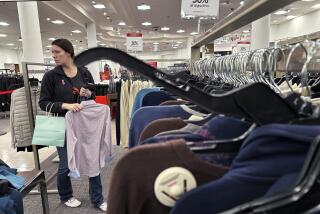Factories Begin to Feel Bite of Fed’s Rate Hikes
- Share via
WASHINGTON — U.S. manufacturing expanded in June at the slowest pace in 17 months as companies began to feel the effect of six interest rate increases by the Federal Reserve in the past year.
The National Assn. of Purchasing Management reported Monday that its monthly factory index fell to 51.8 in June from 53.2 in May. June’s reading was the lowest since January 1999, when manufacturing began to climb out of a yearlong slump in export sales to Asia and Latin America.
“The cumulative impact of the interest rate increases is beginning to bite,” said Kenneth Mayland, president of Clear View Economics in Cleveland. Manufacturing’s momentum “is rapidly being bled away,” he said.
Meanwhile, business at service companies and others not involved in manufacturing grew at a faster pace in June, another NAPM survey showed. The NAPM’s non-manufacturing business index rose to 64.0 last month from 61.5 in May, putting it close to its record of 65.0 set in April.
“The service side of the economy is going to continue to show steady and considerable growth” even as manufacturing shows signs of slowing, Mayland said.
Another report out Monday showed that U.S. construction spending barely budged in May, boosted only by an increase in work on factories and office buildings. Spending rose 0.1% in May after falling 1.1% in April, the Commerce Department said. Recent data point to cooler demand for U.S. manufactured goods other than semiconductors and other electronic equipment.
U.S. industrial production slowed in May--rising 0.4% after 0.7% gains the previous two months, the Fed reported two weeks ago. A decline in output of goods related to housing, autos and other interest-rate-sensitive industries contributed to the slowdown, while business equipment output rose, led by a 4.4% rise in production of semiconductors.
Orders for durable goods rose 6% in May, mostly because of a 26% jump in demand for electronic goods, the Commerce Department reported last week.
A similar pattern showed in Monday’s NAPM manufacturing report. “The loss of momentum that’s reflected by the survey is ‘old-economy’-type industries as opposed to high-tech,” Mayland said.
Demand for wireless communications equipment is helping companies such as Motorola Inc. The No. 2 maker of cellular phones said recently that sales of wireless network equipment will rise 20% this year, exceeding its previous forecast of 15%.
U.S. manufacturers struggled for more than a year, beginning in late 1997, after foreign customers cut back their orders as a recession hit Asia and Latin America. As they began to recover in early 1999, demand for U.S.-made goods at home and overseas soared to a level that worried Fed policymakers. Since June 1999, the Fed raised the overnight bank lending rate six times to a nine-year high of 6.5%, pushing up borrowing costs for businesses and consumers.
Economic statistics in the last month suggest higher rates have started to curtail home buying and sales of cars and other retail goods. That, in turn, has cut into orders for factory goods.
“It makes sense that orders might slow,” said Tony Crescenzi, chief U.S. bond strategist at Miller, Tabak & Co. in New York. “Ultimately the production side of the economy is consistent with the demand side, and the demand side is slowing.”
The NAPM’s manufacturing report showed that the production index, a gauge of current output, fell to 53.6 in June--the lowest since January 1999--from 56.3 in May. The new-orders index, a gauge of current demand, fell to 50.6 in June--the lowest since December 1998--from 51.1 in May.
The NAPM’s prices-paid index in June fell to 61.2--the lowest since August 1999--from 65.8 in May. The prices index has fallen since March, when it reached a five-year high of 79.8.
(BEGIN TEXT OF INFOBOX / INFOGRAPHIC)
Construction Spending
In billions of dollars, seasonally adjusted:
May: $809.3 billion
Source: Commerce Department
More to Read
Inside the business of entertainment
The Wide Shot brings you news, analysis and insights on everything from streaming wars to production — and what it all means for the future.
You may occasionally receive promotional content from the Los Angeles Times.










